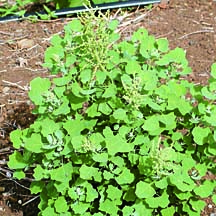
In the Garden![]()
‘Aweoweo
LATIN NAME
Chenopodium oahuense
With all the news about people fishing for 'aweoweo at Heeia pier and other areas, I thought it would be interesting to share information about this Hawaiian plant with the same name.
If you're wondering why a fish and a plant share the same name, you must go all the way back to the beginning: the Kumulipo. In this Hawaiian creation chant, many things are created in a dualistic manner, meaning that when one thing is created in the ocean, there is often a counterpart created on land or in the air, and vice versa.
Description: Low shrubs to small trees growing 2 to 8 feet tall with light blue-green leaves that are in the shape of a goose's foot. The leaves can be tiny, about 1-1/2 inches across, or they can be up to 2 inches depending on growing conditions.
Usually, less water and more sun will result in smaller, thicker leaves, whereas regular watering will lead to thin leaves as shown in the accompanying picture, in which the flowers are very small and appear in clusters above the plant.
The young stems are usually streaked with red, just like the fish. And when the leaves and flowers are crushed, they smell just like the fish, too! Fo' real! Don't crush them if you don't want to worry about the plant stinking up your yard.
Distribution: 'Aweoweo is found in drier, harsh habitats near the ocean, in the lowland dry forest or all the way up in the subalpine shrub land of the large volcanoes like Mauna Kea. Although its species name is oahuense, this endemic plant is found on all the main Hawaiian islands except Kahoolawe (it was probably found there before) and on most of the Northwestern Hawaiian Islands.
Landscape use and care: This plant is bulletproof! It likes full sun and requires little watering, leading to practically none once established. Few bugs attack this plant, either. You may occasionally notice some scales, but they can be easily removed by hand.
Cultural uses: The young leaves and stems are wrapped in ti leaves and steamed to be eaten in times of famine. The harder wood at the plant's base can also be shaped into fishhooks so you can catch 'aweoweo with 'aweoweo.
Gardening Calendar


